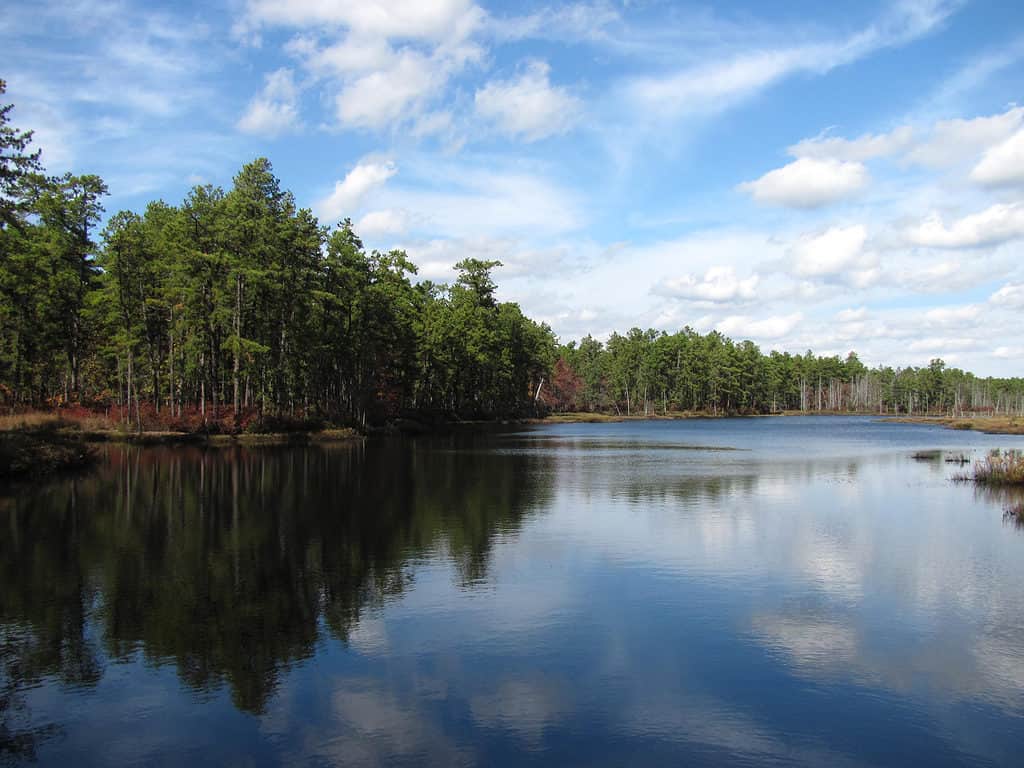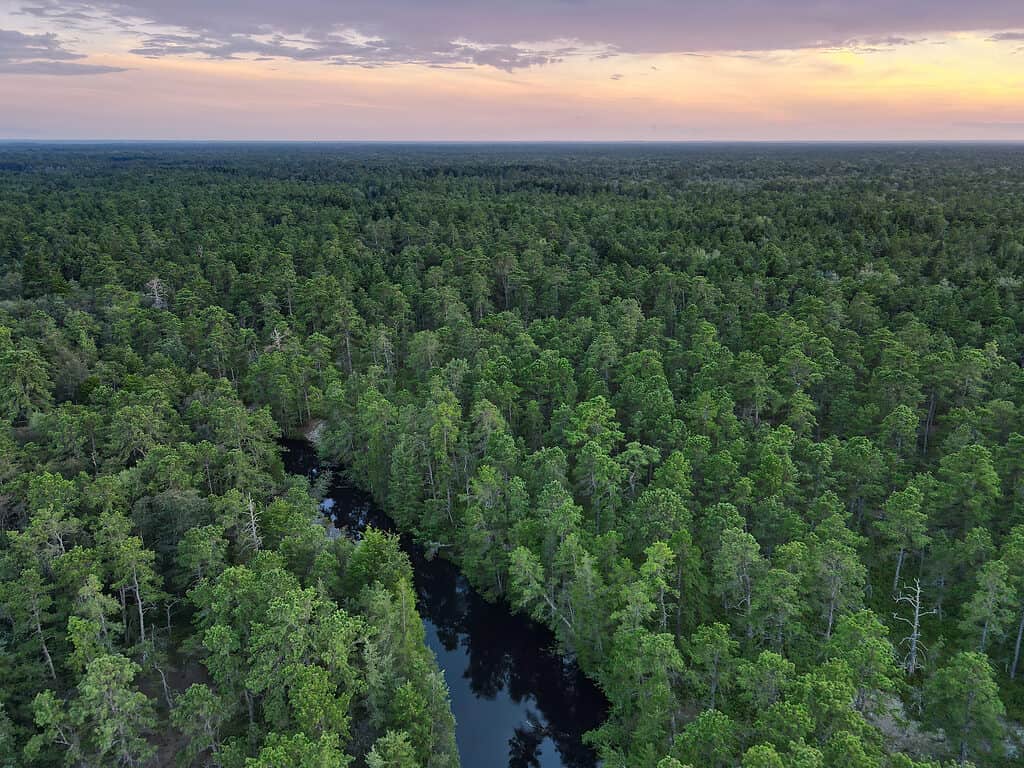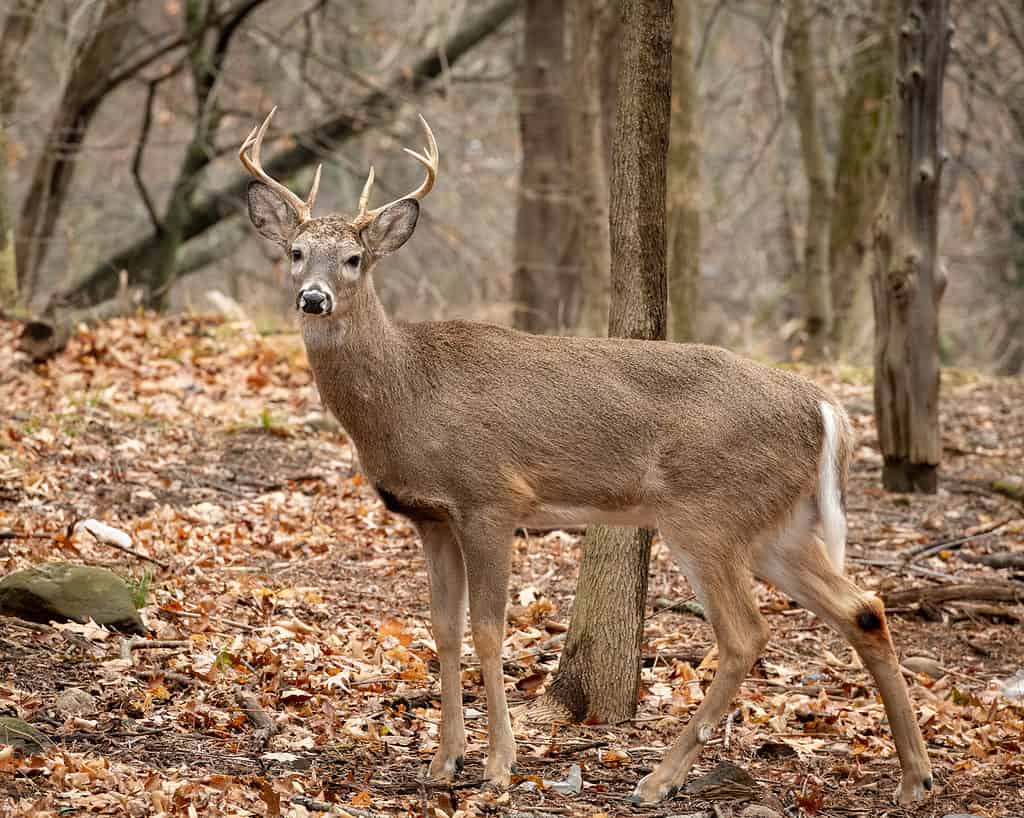The State of New Jersey has bountiful forested lands. There are at least 11 forests in the state, all taking up a total land area of about 430,928 acres. That’s about 7.7% of the total land area of the state. Of these, the largest and most popular forest in New Jersey is the Wharton State Forest.
Every year, an average of about 17.8 million visitors visit the parks and forest areas of New Jersey for a wide range of recreational activities. This article details all you need to know about the largest forest in New Jersey, including its history, unique features, and plant and animal life.
What Is the Largest Forest in New Jersey?
The largest forest in New Jersey is the Wharton State Forest. This massive tract of land covers a total of about 122,880 acres of land in the Pinelands. It is located on the northeastern edge of Hammonton.
Wharton State Forest is the largest state forest in New Jersey. Since it is part of the New Jersey Pinelands National Reserve, the forest is governed by laws intended to protect the plants and animal species found in the region. Not only is Wharton famous for its protected plants and animal species, it is also a popular destination for various recreational activities. These include hiking, camping, fishing, and other outdoor activities.

Wharton State Forest is home to several lakes, trails and historic sites, and is the largest forest in New Jersey.
©New Jersey Pinelands Commission, CC BY-SA 4.0 <https://creativecommons.org/licenses/by-sa/4.0>, via Wikimedia Commons – License
Where is the Largest Forest in New Jersey Located?

The Wharton State Forest is located in the heart of the Pine Barrens, named for its dense stands of pine trees that dominate the landscape.
©PTZ Pictures/Shutterstock.com
The Wharton State Forest is located in the heart of the Pine Barrens. This is a vast and largely rural region in the southern part of New Jersey. The tract of land that forms this forest is a part of the Atlantic Coastal Plain. This broad and flat landscape stretches from Virginia to Massachusetts and is characterized by a hot and humid climate.
The name of the Pine Barrens is a reference to the dense stands of pine trees that dominate the landscape. The Pine Barrens is home to a diverse array of plant and animal life that have adapted to the sandy soil and dry, fire-prone conditions of the area.
The Wharton State Forest covers the Atlantic, Burlington, and Camden Counties of New Jersey. It borders the Batsto River on its northern edge. Similarly, the Great Egg Harbor River (Mullica River) is on the southern edge of this forest.
History of the Largest Forest in New Jersey
Between 1766 and 1867, the current location of the Wharton State Forest was popular as a bog iron and glass manufacturing site. The historic Batsto Village was the center of activities in the region at the time. By the 1870s, industrial activities slowed significantly in the region, and there were many abandoned communities in the area.
In 1873, an industrialist by the name of Joseph Wharton, who had plans of tapping the groundwater in the Pine Barrens region for export to Philadelphia, began acquiring all the abandoned lands in the area. He purchased Batso Village in 1873 and ended up with about 100,000 acres of land in the region.
A new law that prohibited water export blocked Wharton’s vision to build dams and redirect freshwater to Philadelphia in 1884. Still, he invested efforts in improving infrastructure, forestry, farming, and lumbering activities in the region.
After Joseph Warton died in 1909, his properties were held in trust by the Girard Trust Company. The New Jersey government purchased a large portion of the land in 1954. Subsequently, the state designated the Wharton State Forest for conservation and recreational purposes.
Unique Features and Plant Life of the Largest Forest in New Jersey
Apart from the massive size of the largest state forest in New Jersey, it is also a unique landscape that plays host to a variety of plants and animals. In addition to the natural spectacles, there are several historical and cultural sites within the Wharton State Forest. The Batsto Village, Atsion Recreation Area, and Oswego River Natural Area are some of the major sites in the forest. The Batsto Village alone has about 33 historic buildings and other monumental structures.
Wharton State Forest is also a popular destination for a relaxing outdoor experience. Visitors enjoy exploring the forest hiking trails, campgrounds, fishing spots, and other recreational activities.
One of the unique features of the Wharton State Forest is its dense stands of pine trees, which dominate the landscape and give the region its name. The pine trees of the Pine Barrens, including pitch pine, shortleaf pine, and loblolly pine, are adapted to the region’s sandy soil.
Fires are frequent in the region, but the trees have a wide range of adaptations to help them survive the fires year after year. In addition to the pine trees, the forest is also home to oak, cedar, and other evergreen species, creating a diverse and dynamic ecosystem.

Wharton State Forest is home to historical Batsto Village, a 19th-century iron-making town that is now a National Historic Landmark.
©Belikova Oksana/Shutterstock.com
Wildlife Found in the Wharton State Forest
The Wharton State Forest is home to a lot of plants and animals. One of the most iconic animals of the Pine Barrens is the white-tailed deer, which is found throughout the region and is a common sight in the forest. The deer is a popular game animal known for its distinctive white tail, which raises and wags when it is alarmed.
Other mammals that you may find in the forest include black bears, wild turkeys, red and gray foxes, and a variety of small mammals such as rabbits, squirrels, and chipmunks. The forest hosts several reptiles and amphibian species, including snakes, turtles, and frogs.
Wharton is also home to a wide variety of birds. The numerous lakes, streams, and wetlands in the region attract different kinds of waterfowl. The forest is a popular destination for bird watchers, who come to see a variety of species. Some of the birds here include woodpeckers, owls, bald eagles, marsh hawks, great blue herons, red-tailed hawks, hummingbirds, goldfinch, and turkeys.
In addition to its abundant wildlife, the Wharton State Forest is also a safe haven for several endangered and threatened species, such as the red-shouldered hawk, which is listed as endangered in the state. Others include the New Jersey pine snake, barred owl, and red-headed woodpecker. These endangered species are protected by state and federal laws. Efforts are underway to conserve and protect their habitat in the forest.

White-tailed deer, known for their distinctive white tail, are a common sight in the Wharton State Forest.
©Herbie Pabst/Shutterstock.com
Ecological Importance
The Wharton State Forest is an ecologically important landscape. It has a far-reaching impact on the plants, animals, and human inhabitants of the region, as well as the broader ecosystem of New Jersey. It is the major component of the remaining contiguous forest block in New Jersey.
The majority of the land in the forest is protected from development. This helps to safeguard the habitats within the forest and protects the endangered and threatened species that are adapted to the unique conditions of the Pine Barrens region.
The forest is an important source of clean air and water for the region. It helps to filter pollutants and protect water quality in the numerous lakes, streams, and wetlands that are found in the region.
The Wharton State Forest is an important resource for the people of New Jersey. It provides recreational opportunities and a place for people to connect with nature. Recreational areas are abundant in the forest. There are several campsites, cabins, and other recreational rentals.
In addition to its ecological value, the Wharton State Forest is also an important cultural and historical resource. It is home to several historical and cultural sites. One of them is the Batsto Village, a 19th-century iron-making town that is now a National Historic Landmark. The region also has several other small towns and villages that were founded by early European settlers.
Conclusion
The Wharton State Forest is a beautiful and diverse landscape that is rich in history and natural beauty. It is an important part of New Jersey’s natural and cultural heritage. Wharton State Forest is also a popular destination for outdoor enthusiasts and visitors from all over the state and beyond.
The photo featured at the top of this post is © Patrick Tappe/Shutterstock.com
Thank you for reading! Have some feedback for us? Contact the AZ Animals editorial team.







